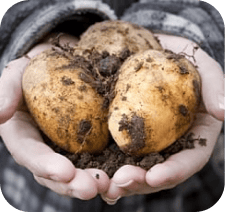Unlike plants grown in the ground, potted plants enjoy a relatively pest-free environment. In most cases, they are potted in quality soils or soilless mixes, and are often grown closer at hand, so they are inspected more frequently. As a result, they tend to have fewer problems with insects and disease.
With that said, there’s no predicting what could attack your plants. Just because they are confined to pots does not mean that they will be excluded from pest problems. Insects can creep into any garden and fungal spores are present in the air at all times. While the chances of potted plant pests are much smaller with container gardens, you still need to take precautions.

IT'S ORGANIC!
Bon-Neem II
Specially formulated to kill mites, aphids, whitefly and more on contact.
$14.95Learn moreGot bugs? At Planet Natural we offer a large selection of natural and organic pest control solutions that are guaranteed SAFE and effective. Also, visit our Pest Problem Solver for pest pictures, descriptions and a complete list of earth-friendly remedies.
- Purchase only healthy plants and thoroughly wash them before planting. Many insects gain entry (especially indoors) on new plants.
- Always plant in a clean growing media and in clean containers. Do not reuse potting mixes.
- Grow plants in the conditions they prefer (i.e., give them proper sunlight, nutrients and water). Healthy plants are better able to resist insect and disease problems.
- Wash your hands and garden tools after handling infected plants. Insects and fungus often travel from plant to plant on dirty tools.
- Remove severely infested plants. Plants that have had more than half of their leaves damaged are probably not worth saving.
No matter how careful you are, sooner or later you may have to deal with a pest problem of some sort. When that happens, don’t send out an SOS. Think IPM. That stands for Integrated Pest Management and it’s a great way to conduct organic pest control.
IPM combines various techniques to produce a long term control of the pest population. It consists of the following:
- Monitoring for pests on a regular basis.
- Identifying the pest and understanding its life-cycle so that treatment can be chosen and timed to be most effective.
- Establishing a tolerable threshold of injury. The emphasis is on control, not eradication.
- If action is required, begin with safe and sensible pest control measures that are the least harmful to you and the environment.
Tip: Since most container plants need to be watered daily, use this time to check over the leaves, paying close attention to the undersides of leaves.
When growing in containers, it is often easier to handpick larger pests — like caterpillars, slugs and snails — and destroy them than it is to deal with a toxic can of Bug-B-Gone.
Problems with smaller pests, like spider mites, aphids and whitefly, can be tougher to control and may spread several plant diseases.
Note: Sometimes a heavy stream of water from a garden hose is all that is needed to reduce many pest infestations.

Home Remedies for Natural Pest Control
Long before there were chemical pesticides, there were gardeners. Here you will find how they dealt with the common problems we all face today.
Plant Diseases
Fungicides are among the most toxic chemical in the gardener’s arsenal. Use organic fungicides, when possible or try these least-toxic alternatives:
- Listerine – Mix 1 teaspoon of Listerine into 1 quart of warm water.
- Hydrogen Peroxide – 1 Tablespoon per gallon of water.
- Baking Soda/Oil Combination – 1/2 Tablespoon Baking soda, 1/4 teaspoon cooking oil mixed in 1 quart of warm water.
All of the above recipes should be mixed directly into the sprayer and applied every 10 days or until there is no evidence of fungus.

OMRI LISTED
Safer Soap
The original insecticidal soap! Concentrated formula makes 6 gallons of spray.
Learn moreSafer®Insecticidal Soap is made from naturally occurring plant oils and animal fats. Penetrates the protective outer shell of soft bodied insect pests and causes dehydration and death within hours. OMRI Listed for use in organic production.
Insect Pests
Alcohol for mealy bugs: Indoor plants are susceptible to mealy bugs, which are identified as white, cottony looking fuzz on the undersides of leaves and in the leaf joints. Here’s how to control them:
Dip a Q-tip into rubbing alcohol and then directly apply it on the mealybugs. The bugs will disintegrate, leaving your plant unharmed.
Soap/Oil spray for container plants: Probably the best overall insecticide, this recipe is made from dish washing liquid and cooking oil. You do need to apply it more frequently than chemical pesticides, but who wants to use poison around the home? Here is the recipe:
- 1/2 teaspoon dishwashing liquid
- 1/4 teaspoon cooking oil
- 1-quart warm water
Mix all ingredients in a small spray bottle. Mist upper and under sides of leaves every 10 days to control mealy bug, spider mite, aphid, thrips, or any other sucking or chewing insect.











